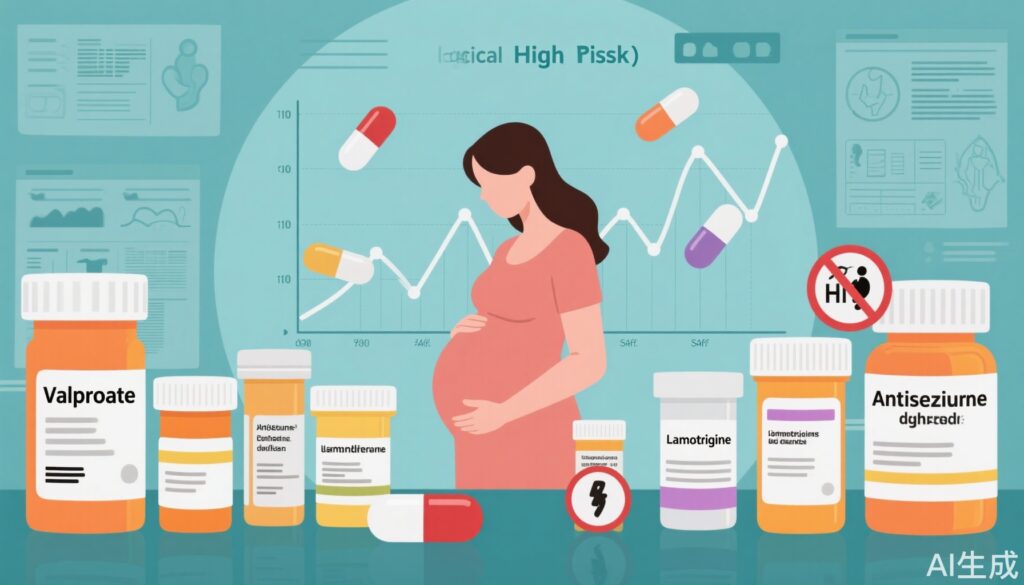Highlight
- Sharp declines in prenatal exposure to high-risk antiseizure medications (ASMs), particularly valproic acid and valpromide, were observed in France from 2013 to 2021.
- Use of the safest ASMs—lamotrigine and levetiracetam—increased, but prescriptions for newer drugs with uncertain safety profiles, such as pregabalin and gabapentin, rose substantially.
- Disparities in ASM exposure persist: socially deprived women are more likely to be exposed to ASMs with uncertain or acknowledged risks.
- Rising exposure to newer, less-studied ASMs underscores urgent gaps in evidence and the need for enhanced risk reduction strategies.
Background
Epilepsy and other seizure disorders affect an estimated 0.3–0.7% of pregnancies globally, making seizure management during pregnancy a critical challenge. Uncontrolled seizures endanger both maternal and fetal health, but many antiseizure medications (ASMs) carry teratogenic and neurodevelopmental risks. Valproic acid, in particular, is strongly linked to major congenital malformations and cognitive impairment in exposed offspring, leading to international calls for tight prescription controls. Recent years have witnessed the advent of newer ASMs, yet comprehensive perinatal safety data remain scarce. As prescribing patterns evolve, ongoing surveillance is essential to balance maternal seizure control with fetal safety.
Study Overview and Methodological Design
The study by Shahriari et al., published in Neurology (2025), is a nationwide, population-based cohort analysis using the French National Mother-Child Register. The investigators included 8,669,502 pregnancies between 2013 and 2021, identifying 55,801 with documented ASM exposure. ASMs were categorized into three safety tiers:
- Safest: Lamotrigine, levetiracetam
- Uncertain risk: Pregabalin, gabapentin, clonazepam, oxcarbazepine, and newer ASMs
- Acknowledged risk: Valproic acid, valpromide, carbamazepine, topiramate, phenobarbital, phenytoin, primidone
Maternal age (15–49 years), socioeconomic status (based on health insurance), and diagnosis codes (ICD-10) were recorded. The primary endpoint was the temporal change in ASM exposure rates, stratified by safety group, year, diagnosis, and social indicators. Analysis spanned the full study period and three sub-periods (2013–2015, 2016–2018, 2019–2021).
Key Findings
Figure 1 Annual Number of ASM-Exposed Pregnancies, by ASM Safety Category and ASM
Over the nine-year period, prenatal exposure to valproic acid and valpromide declined dramatically—by 84% and 89%, respectively. This was paralleled by marked reductions in multiple dispensations (-86% and -93%) and sustained live birth exposures (-91% and -96%). However, terminations among pregnancies exposed to these high-risk agents rose (+23% for valproate, +28% for valpromide), possibly reflecting increased awareness of fetal risks and/or improved detection of exposed pregnancies.
Table 1 Maternal and Pregnancy Characteristics
| ASM-unexposed pregnancies (N = 8,613,701) | ASM-exposed pregnancies | |||
|---|---|---|---|---|
| ASMs considered the safest (N = 27,821) | ASMs with uncertain risk (N = 19,456) | ASMs with acknowledged risk (N = 13,485) | ||
| Age at the pregnancy start | ||||
| Mean ± SD | 29.7 ± 5.8 | 30.2 ± 5.8 | 31.9 ± 5.9 | 31.2 ± 6.2 |
| 15–24 | 1,649,523 (19.2) | 4,876 (17.5) | 2,243 (11.5) | 2,074 (15.4) |
| 25–34 | 5,184,235 (60.2) | 16,242 (58.4) | 10,507 (54) | 7,037 (52.2) |
| 35–49 | 1,779,943 (20.7) | 6,703 (24.1) | 6,706 (34.5) | 4,374 (32.4) |
| Level of resourcesa | ||||
| Low | 1,165,341 (13.5) | 3,833 (13.8) | 3,606 (18.5) | 2,408 (17.9) |
| Intermediate | 1,592,100 (18.5) | 5,739 (20.6) | 3,605 (18.5) | 2,114 (15.7) |
| High | 1,767,593 (20.5) | 4,334 (15.6) | 2,399 (12.3) | 1,173 (8.7) |
| Unknown/no salary | 4,088,667 (47.5) | 13,915 (50.0) | 9,846 (50.6) | 7,790 (57.8) |
| Pregnancy outcome | ||||
| Livebirth | 6,298,141 (73.1) | 20,674 (74.3) | 13,142 (67.6) | 8,096 (60.0) |
| Stillbirth | 32,043 (0.4) | 121 (0.4) | 94 (0.5) | 91 (0.7) |
| Pregnancy terminationb | 1,757,500 (20.4) | 5,215 (18.7) | 4,840 (24.9) | 4,373 (32.4) |
| Otherc | 526,017 (6.1) | 1,811 (6.5) | 1,380 (7.1) | 925 (6.9) |
Exposure to the safest ASMs, lamotrigine and levetiracetam, increased by 30%, highlighting a shift toward drugs with stronger safety records. Yet, use of ASMs with uncertain perinatal risks surged by 33%; notably, pregabalin exposure rose by 49%, gabapentin by 27%, and newer agents by an alarming 140%.
Carbamazepine and topiramate exposures declined by 40% and 34%, but nearly 600 newborns remained exposed to each drug in the final study years. Socioeconomic disparities emerged: women with lower resources had higher rates of exposure to ASMs with uncertain or known risks (18.5% and 17.9%) compared to those receiving the safest categories (13.8%) or no ASMs (13.5%).
Figure 2 Outcomes of ASM-Exposed Pregnancies Over Time by ASM Safety Category and ASM
Lamotrigine use for mood disorders (rather than epilepsy alone) increased by 51%, with a corresponding 35% rise in terminations, suggesting complex risk–benefit considerations in psychiatric populations. Terminations also climbed among pregnancies exposed to high-risk ASMs.
Mechanistic Insights and Pathophysiological Context
The teratogenicity of valproic acid is well-established and attributed to its interference with folate metabolism, histone deacetylase inhibition, and direct neurodevelopmental disruption during embryogenesis. Lamotrigine and levetiracetam, by contrast, have more favorable safety profiles, likely due to less interference with key developmental pathways and lower placental transfer rates.
Data on newer ASMs (e.g., pregabalin, gabapentin, oxcarbazepine) remain limited. Pregabalin’s mechanism—modulation of voltage-gated calcium channels—does not inherently imply teratogenicity, but animal studies and emerging epidemiology suggest possible risks of structural and neurodevelopmental abnormalities. The growing use of these drugs without robust safety evidence is concerning.
Clinical Implications
This study’s findings have immediate practical relevance:
- Prescribers are shifting away from the most teratogenic ASMs, especially valproate, in line with regulatory guidance and public health campaigns.
- There is a clear increase in use of safer alternatives, yet the rapid adoption of newer, less-studied ASMs underlines a pressing evidence gap.
- Socioeconomic disparities suggest that women in deprived settings may lack access to safer drugs or comprehensive counseling, warranting targeted interventions.
- The rising use of lamotrigine in psychiatric indications (e.g., bipolar disorder) highlights a need for nuanced, multidisciplinary risk assessment in women of childbearing age.
Clinicians should continue to prioritize ASMs with the most favorable safety profiles, but remain vigilant about the uncertain risks associated with newer drugs, especially in the absence of robust pregnancy registry data.
Limitations and Controversies
The study’s strengths include its large, population-based design and robust data sources. Limitations include potential misclassification of drug exposures (reliant on pharmacy dispensing data), lack of granular information on seizure control or indication for ASM use, and limited follow-up on long-term neurodevelopmental outcomes. The observed rise in pregnancy terminations among exposed women could reflect both increased detection and changing societal attitudes, complicating causal interpretation. There remains ongoing debate about the real-world safety of newer ASMs, and their use should be accompanied by comprehensive risk–benefit counseling.
Expert Commentary or Guideline Positioning
Current guidelines from the International League Against Epilepsy (ILAE) and the American Academy of Neurology (AAN) advocate for the use of monotherapy with ASMs of lowest known teratogenic risk in women planning pregnancy, with avoidance of valproic acid whenever possible. This study reinforces these recommendations, but also highlights that clinical inertia, drug availability, and non-epilepsy indications (such as psychiatric disorders) complicate real-world prescribing.
Conclusion
The landscape of antiseizure medication use in pregnancy is evolving, with encouraging reductions in exposure to the most teratogenic agents and greater adoption of safer alternatives. However, the rapid increase in use of newer ASMs with limited safety data, and persistent disparities in drug exposure by socioeconomic status, demand both enhanced surveillance and targeted risk reduction strategies. Continued investment in pregnancy registries, mechanistic research, and education—especially among vulnerable populations—is essential to ensure optimal outcomes for both mothers and children.
References
1. Shahriari P, Drouin J, Miranda S, Bougas N, Botton J, Dray-Spira R. Trends in Prenatal Exposure to Antiseizure Medications Over the Past Decade: A Nationwide Study. Neurology. 2025 Aug 26;105(4):e213933. doi: 10.1212/WNL.0000000000213933 IF: 8.5 Q1 .2. Tomson T, Battino D, Bromley R, et al. Management of epilepsy in pregnancy: a report from the International League Against Epilepsy Task Force on Women and Pregnancy. Epileptic Disord. 2019;21(6):497-517.
3. Harden CL, Meador KJ, Pennell PB, et al. Management issues for women with epilepsy—focus on pregnancy (an evidence-based review): II. Teratogenesis and perinatal outcomes. Epilepsia. 2009;50(5):1237-1246.


